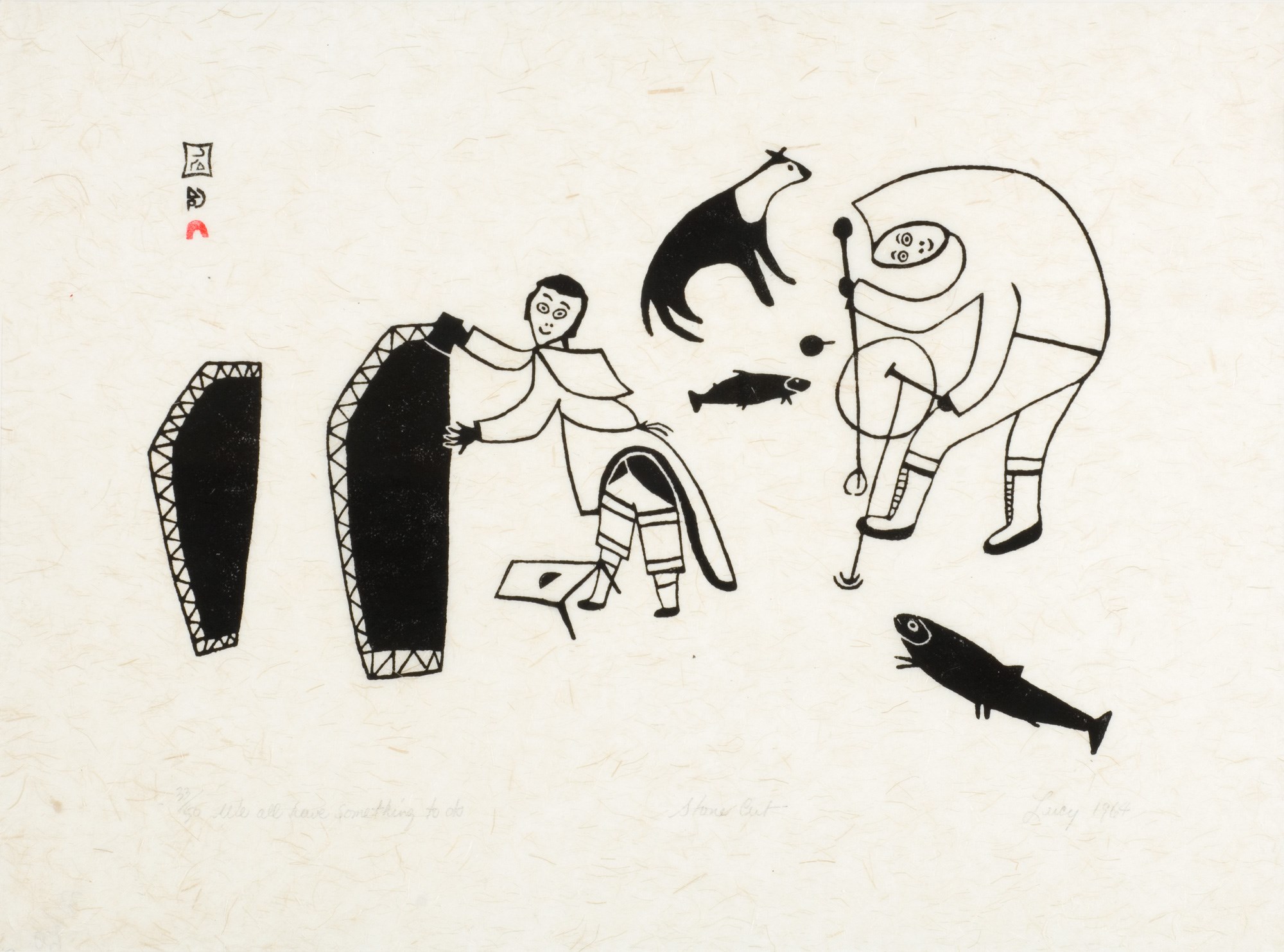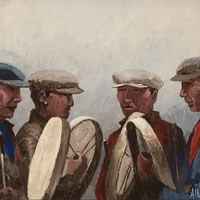We All Have Something To Do
When invited to select a work from the Senate to write about, I hesitated before landing on this choice. There were other pieces that interested me because of who owned them, because of who was represented in them, because of what they were used for, or because they were a better fit for my comfort level or realm of knowledge. But I kept coming back to this one. A simple yet strong statement in its title as much as in its representation. A message so universally true and with so many potential meanings that it kept calling me back and compelling me to push my discovery.
Many people are aware of Kinngait (Cape Dorset), Nunavut, as a powerhouse of Inuit printmaking. The artform was first introduced in the area by James Houston in the late 1950s. The Inuit have a long-standing mastery of stone and bone carving, outstanding design skills as evidenced in the beautiful sealskin appliqués that adorn their traditional outerwear, with storytelling intrinsically woven into daily life. But this medium was new. Completely new. Paper, graphite pencils, transferring ink. Houston was able to encourage some Sikusalingmiut to give it a try, in an experiment that would prove that the spirit of innovation that had carried Inuit culture through thousands of years could be transferred into new realms, onto paper.
Lucy Qinnuayuak was one of the most prolific and well-known artists in the years when the West Baffin Eskimo Cooperative established itself and the Cape Dorset artists exploded on the national and international scenes. From 1961 until 1983, her work appeared in all but one of the annual print catalogues, a production and release endeavour overseen and approved by the Canadian Eskimo Art Committee. Her imaginary birds, scenes of busy people living life out on the land, her light-hearted tone and humour were captured and selected for release over 100 times. Every print catalogue is available online today, and they provide us a breadth of knowledge and perspective, including insightful interviews with Lucy. I was struck by her feeling that it was only after the printing process was completed that she could see that her design was indeed good, and that it pleased her to know that people liked her drawings and knew her from her drawings, even though she would never meet them.
‘We all have something to do’ quite simply reminds me that everybody has a role to play in everyday life. In this case we see a man busy fishing, a woman busy stretching skins, and even a dog busy waiting to be of service. I see a story of purpose, of sharing duties, for a healthy daily dose of sense of worth and accomplishment.
Interestingly, this collaboration and shared sense of accomplishment was also transposed into the printmaking industry in Kinngait. Although Lucy was indeed one of its most prolific design artists, she – like many others – never did venture into the stencil-making, stone-cutting, inking, pressing or pulling processes required to transform a design into a published print. Each of those steps required their own sets of skills and expertise, and Lucy trusted and respected her colleagues’ roles in the collective’s printmaking process. She herself felt that it was only once the entire process was completed that she could see the worth of her part in the shared endeavour. ‘We all have something to do’.
Where does that leave me in this unexpected encounter, faced with an image of a Lucy print that has made its way through a private collector to be displayed at the Senate of Canada to tell me a story today? I like to think that the fact that I liked this piece from the start without knowing why would have made Lucy happy, despite the fact we will never meet. It is my simple, but fitting, ‘something to do’ in the continued life of this print.
Vania Gagnon is the Director of the Musée Saint-Boniface Museum in Winnipeg, Manitoba.

Object details
Artist
Lucy Qinnuayuak
Inuit culture
Salluit, Nunavik, Quebec, 1915
Cape Dorset, Nunavut, 1982
Title
We All Have Something To Do
Date
1964
Medium
Stonecut
Dimensions
H: 89 cm
W: 74 cm
Credit
Part of the National Capital Commission’s Official Residences Crown Collection
Image copyright
© Dorset Fine Arts




